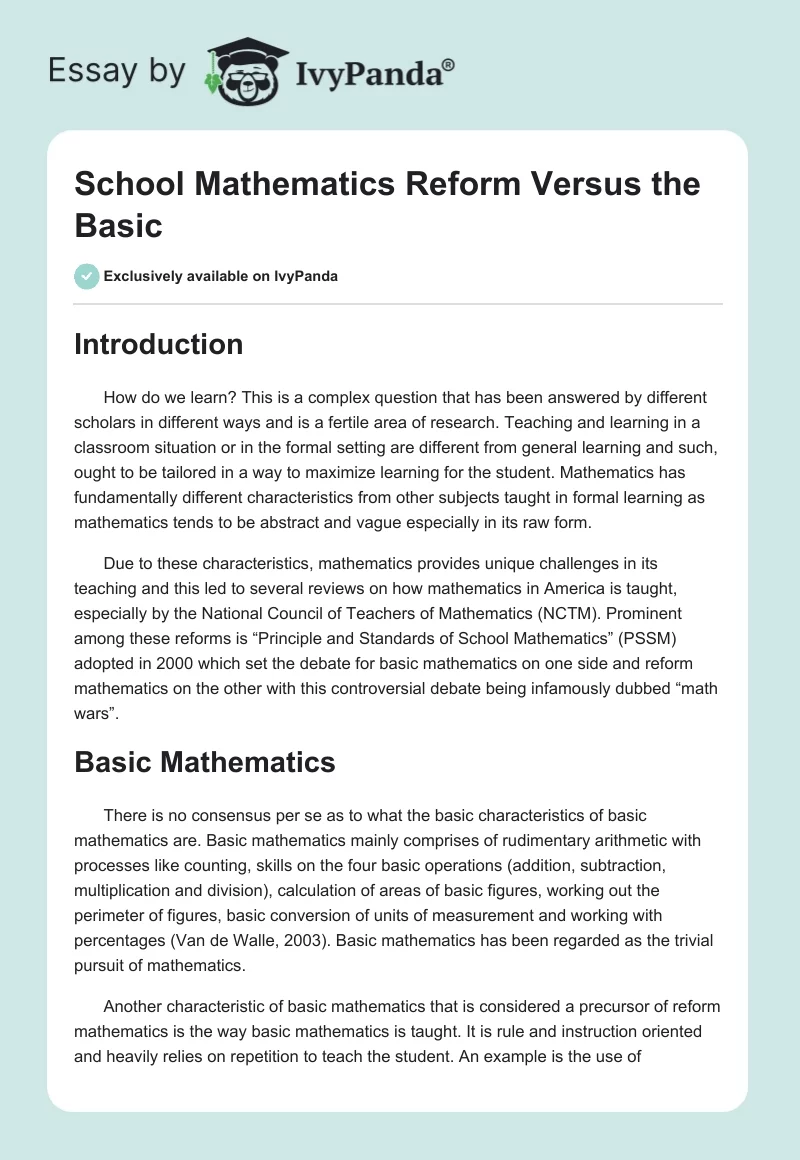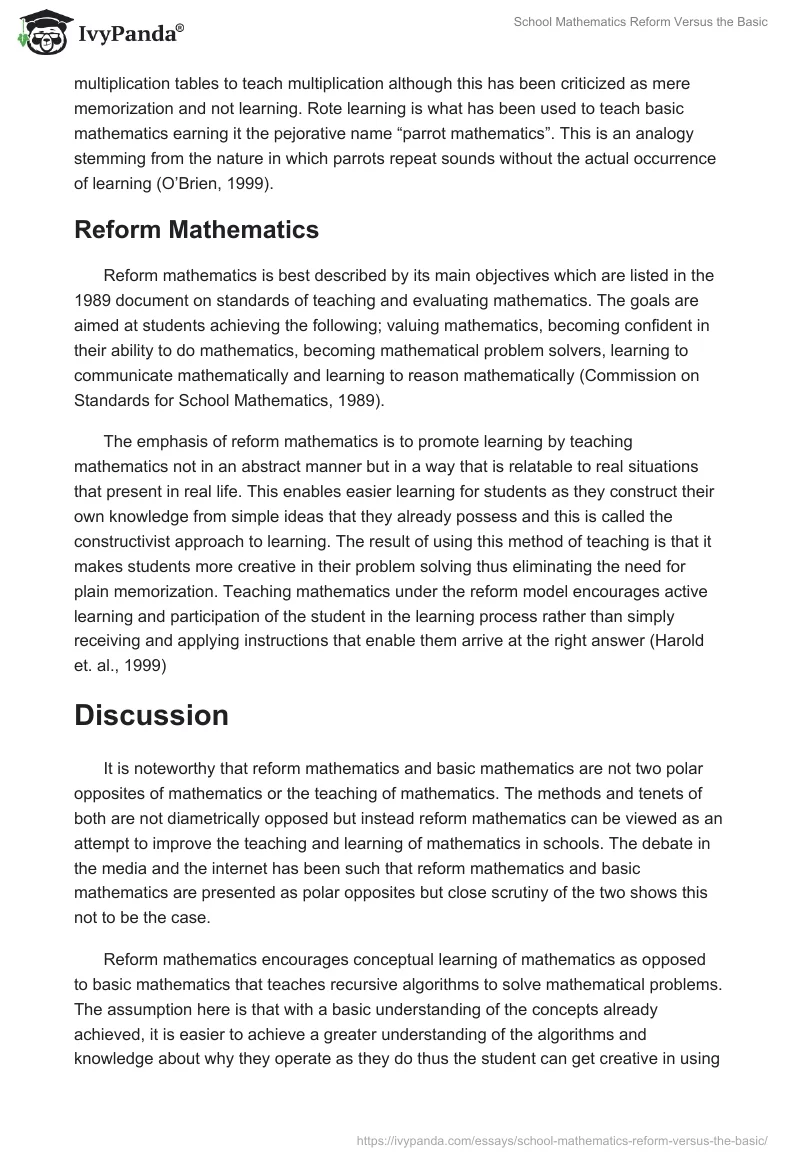Introduction
How do we learn? This is a complex question that has been answered by different scholars in different ways and is a fertile area of research. Teaching and learning in a classroom situation or in the formal setting are different from general learning and such, ought to be tailored in a way to maximize learning for the student. Mathematics has fundamentally different characteristics from other subjects taught in formal learning as mathematics tends to be abstract and vague especially in its raw form.
Due to these characteristics, mathematics provides unique challenges in its teaching and this led to several reviews on how mathematics in America is taught, especially by the National Council of Teachers of Mathematics (NCTM). Prominent among these reforms is “Principle and Standards of School Mathematics” (PSSM) adopted in 2000 which set the debate for basic mathematics on one side and reform mathematics on the other with this controversial debate being infamously dubbed “math wars”.
Basic Mathematics
There is no consensus per se as to what the basic characteristics of basic mathematics are. Basic mathematics mainly comprises of rudimentary arithmetic with processes like counting, skills on the four basic operations (addition, subtraction, multiplication and division), calculation of areas of basic figures, working out the perimeter of figures, basic conversion of units of measurement and working with percentages (Van de Walle, 2003). Basic mathematics has been regarded as the trivial pursuit of mathematics.
Another characteristic of basic mathematics that is considered a precursor of reform mathematics is the way basic mathematics is taught. It is rule and instruction oriented and heavily relies on repetition to teach the student. An example is the use of multiplication tables to teach multiplication although this has been criticized as mere memorization and not learning. Rote learning is what has been used to teach basic mathematics earning it the pejorative name “parrot mathematics”. This is an analogy stemming from the nature in which parrots repeat sounds without the actual occurrence of learning (O’Brien, 1999).
Reform Mathematics
Reform mathematics is best described by its main objectives which are listed in the 1989 document on standards of teaching and evaluating mathematics. The goals are aimed at students achieving the following; valuing mathematics, becoming confident in their ability to do mathematics, becoming mathematical problem solvers, learning to communicate mathematically and learning to reason mathematically (Commission on Standards for School Mathematics, 1989).
The emphasis of reform mathematics is to promote learning by teaching mathematics not in an abstract manner but in a way that is relatable to real situations that present in real life. This enables easier learning for students as they construct their own knowledge from simple ideas that they already possess and this is called the constructivist approach to learning. The result of using this method of teaching is that it makes students more creative in their problem solving thus eliminating the need for plain memorization. Teaching mathematics under the reform model encourages active learning and participation of the student in the learning process rather than simply receiving and applying instructions that enable them arrive at the right answer (Harold et. al., 1999)
Discussion
It is noteworthy that reform mathematics and basic mathematics are not two polar opposites of mathematics or the teaching of mathematics. The methods and tenets of both are not diametrically opposed but instead reform mathematics can be viewed as an attempt to improve the teaching and learning of mathematics in schools. The debate in the media and the internet has been such that reform mathematics and basic mathematics are presented as polar opposites but close scrutiny of the two shows this not to be the case.
Reform mathematics encourages conceptual learning of mathematics as opposed to basic mathematics that teaches recursive algorithms to solve mathematical problems. The assumption here is that with a basic understanding of the concepts already achieved, it is easier to achieve a greater understanding of the algorithms and knowledge about why they operate as they do thus the student can get creative in using mathematics. This way, manipulation of related mathematical operations is easier and progression towards solutions of more complex mathematical problems is achieved gradually once the student has a firm grasp of the fundamentals
In an argument that impugns reform mathematics, it is reasoned that basic understanding of mathematics is necessary before students engage in attempts to understand mathematics on a conceptual level. This fundamental understanding, according to this argument, is best achieved through time-tested teaching methods that have been in use in teaching what is now referred to as basic mathematics. Students should first go through the traditional rote learning of mathematics before trying to apply mathematics or understand it on a conceptual level. Algorithms, instructions and the practice of mathematics using these instructions ought to be mastered before any attempt to modify the methods of solving mathematical problems.
Reform mathematics has been accused of being “fuzzy mathematics” in its attempt to be relatable to real life situations. Mathematical problems are often presented in a way that is not straightforward and the mathematics may be lost to the student due to the presentation of the mathematical problem in a way that it seems secondary to the language. It is difficult, for example, to teach mathematics to a student that is not fluent in English when the mathematical problem is presented in English language rather than the traditional figures and symbols of traditional mathematics.
Conclusion
The debate on reform mathematics versus basic mathematics is far from over. It has been complicated by the uncritical and sensational input from the media and other parties that do not fully comprehend the issues at the centre of the debate. The presentation of the two curricula as two fundamentally different systems of approach has polarized stakeholders due to the dichotomous nature the debate has been presented in. It is necessary for the integration of the two systems as basic mathematics tends to produce students that are weaker in mathematical skills in the long run while reform mathematics tries to skip over the fundamentals.
A reason that reform mathematics seems impractical to some teachers, for example, is that reform mathematics can be viewed as an attempt to teach insight. It is obviously impossible to teach insight; it is developed as a problem-solving strategy only after an individual is familiar with all the aspects of a problem. The fundamentals are important and a deeper understanding can be fostered through conceptual learning; a sort of meta-mathematics where students are taught the logic behind the mathematical operations that they use.
An integrated system without clear the clear demarcation of basic mathematics versus reform is the best way forward as students have different cognition styles and learning curves. By presenting both options in this hybrid system, students can simultaneously learn the basics and acquire mathematical intelligence. Instead of spending time vindicating basic mathematics or reform mathematics, research should be conducted into ways of harnessing the strengths of both systems into a unified system with the student at the core of this new system.
References
Commission on Standards for School Mathematics. (1989). Curriculum and evaluation standards for school mathematics. Reston, VA: NCTM.
Harold L. S., James T. F., Christian R. H., and Arthur F. C. (1999). Issues and Options in the Math Wars. Phi Delta Kappan, 80, 444-453.
O’Brien, T. C. (1999). Parrot math. Phi Delta Kappan, 80, 434-443.
Van de Walle, J. A., (2003). Reform Mathematics vs. The Basics: Understanding the Conflict and Dealing with It. In Mathematically Sane. Web.


